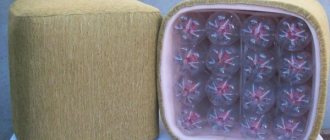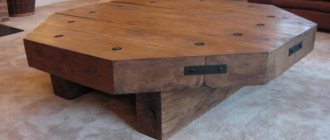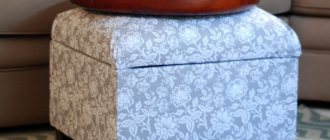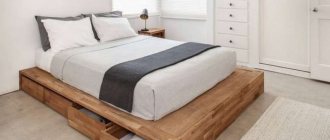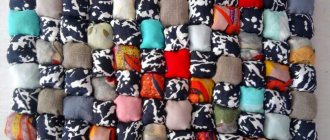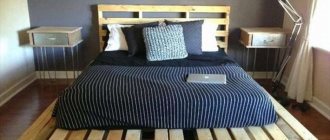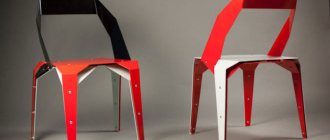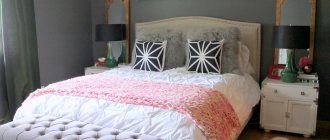What you need to make an ottoman with your own hands
A do-it-yourself rectangular ottoman is usually made from chipboard; if you like everything original, you can try building a frame from bottles. The wooden version is more durable and strong, but bottles will last a long time if handled correctly. The presence of a hinged cover is not necessary, it all depends on the model.
For work use:
- boards 150 cm long and timber 4*4 cm, depending on the design;
- sheets of chipboard or plywood up to 1.3 cm in thickness;
- rollers, if the product is on wheels;
- synthetic winterizer/foam rubber as filler;
- functional decorative upholstery (tapestry, leatherette, etc.);
- self-tapping screws;
- hammer;
- screwdriver, screwdriver;
- furniture nails, construction stapler;
- high-hold adhesive.
To speed up the process, you can use a box with legs. Such products are usually made from beams; self-tapping screws are used for connection.
Important! The hinged lid will expand the functionality of the product. The strength of the finished furniture depends on the reliability of the frame - if you have experience in building beds, then the ottoman will be quite easy to handle
Making a banquette yourself
Making a banquette for the hallway with your own hands consists of several steps. Each of the stages is quite simple, but they all require care and accuracy.
Required materials and tools
Banquettes with wrought iron frames and forging will require certain skills and professionalism. In this article we will look at the possibility of making a wooden bench with your own hands.
Necessary materials:
- Wooden beams measuring 30 by 40 or 30 by 50 mm;
- The legs can be taken from an old stool or coffee table;
- Glue, screws, pins and furniture corners;
- Plywood or MDF sheets.
The upholstery consists of a cover and a filler. The filler is usually foam rubber. It holds its shape well. If you want to make the seat softer, you can take padding polyester.
For manufacturing you will also need the following tools:
- drill, jigsaw and screwdriver;
- hammer;
- screwdrivers;
- needles and threads;
- construction stapler;
- level;
- sandpaper;
- paint, varnish and stain (optional).
Preparatory stage
Before you start making a bench, you should make a drawing. It is necessary to accurately determine the size of the room and the future product.
First you need to decide on the model. A bench with a back will be difficult to implement if you lack experience, so it is better to choose a simple, wooden model without a back. Next, based on the selected model, you need to calculate the dimensions of the remaining parts.
Advice ! If you are planning a lot of parts, then you should make a pattern, and only then start cutting the plywood.
The parts need to be cut out with a jigsaw and their edges treated with sandpaper.
Product assembly
You shouldn’t make all the necessary parts in one day, especially if this is your first experience making furniture. It may happen that you make a lot of mistakes and something will have to be redone.
First of all, you should make a seat and start from its size. Other parts are much easier to fit to the seat.
Then you need to make the legs. As mentioned above, you can take ready-made ones, but if you want to make new ones, especially for the bench, then you need to take the beams, process them using a hand cutter, and attach them to the seat with self-tapping screws. The workpiece must be coated with stain or paint.
Attention ! A hand cutter will make the legs more stylish and neat. This tool is simpler and cheaper than a milling machine
It will allow you to make the legs round or with non-standard protrusions.
If the future product will rest on the sidewalls, then in this case all the parts are prepared at once, cut out, polished, and then simply assembled together. You need to assemble it onto pins; for them, special holes are made at the ends of the workpieces.
After the work has been done, you can begin upholstery. The first day you need to cut out a piece of foam rubber of the required size. And then secure the foam rubber with glue and a construction stapler to the base. It is advisable to place burlap or any coarse material under the foam rubber.
Then from the selected fabric you need to cut out a piece of the required size with an allowance. After cutting, the fabric must be carefully tucked and secured with a construction stapler.
What can you make an ottoman from?
A do-it-yourself pouf with a storage box is made from a wooden or plastic (bottle) base. The presence of a box is not necessary; it can be omitted.
The next stage is the choice of upholstery. Available options:
- textiles - usually linen or cotton, easy to care for, wear-resistant, durable, wide range of colors;
- leather - natural material is expensive, does not fit into any interior, but it looks very prestigious, its disadvantages are the need for careful care, high price;
- leatherette - the visual characteristics are identical to leather, but the price is noticeably lower, the solution looks elegant and neat, and the service life is average.
If you want to create an ottoman that will last forever, you can replace the chipboard base with a metal one. Achieving the desired result will not be easy, but it will not disappoint. Forged products with decorative carvings look beautiful.
Important! Working with forging is difficult; this technology should be chosen only by those who have the appropriate skills.
In addition to the fabric for upholstering the ottoman, they prepare beams for constructing the legs, sheets of plywood, fasteners in the form of screws, staples, stain, paint, and thick foam rubber. Additionally, you can sew a protective cover for the ottoman - but this is at the discretion of the master. The main thing is that the fabric is harmoniously combined with the colors and materials of the hallway or other room.
Important! If you are making an ottoman with legs, you should attach a set of 4 wooden slats to its bottom. This is done so that they protrude beyond the edges of the product up to 2 cm.
Knitting is not used as an option for upholstering an ottoman, but you can make such a cover
Banquette in the form of an open sofa
For manufacturing you will need the following tools and materials:
- Board or furniture board 20-26 mm thick. (If a board is used, then pre-treatment of the material, sanding, and coating with protective compounds will be required).
- Mounting tape for furniture.
- Furniture pins.
- Foam rubber (or other soft filler).
- Screws, self-tapping screws (size 3 cm).
- Drill.
- Wood glue.
- Electric jigsaw.
- Low power screwdriver.
- Hammer, screwdriver.
- Grinding machine.
Stages of work:
- The size of the banquette can be absolutely any. Based on this, you can adjust the dimensions of building materials (boards, furniture panels, wooden blocks). Therefore, having selected a suitable place to place the banquette, take measurements and schematically display a drawing of the future structure.
- The bench will consist of several cubes, each of which has two side walls, a lid, a bottom and a back wall. Due to the fact that the design does not have front walls, the resulting niches can be used as cells for storing things (clothes, bedding, etc.).
- We carry out markings on the board (furniture board) according to the existing drawing. Now we cut out the corresponding parts of the structure. For this you will need a jigsaw. Please note that the top covers of the banquette will be attached to the top of the side walls, and the bottom and back panel will be located at the very bottom of the structure. If the product consists of 3 cubes, then 6 parts will be required to assemble the side walls, as well as 3 parts each for the bottom and rear panels. It is worth saying that a banquette with a back is also made according to a similar scheme.
- After all the necessary parts have been cut, they should be thoroughly sanded. To do this you will need a hand sander and sandpaper.
- Next, we connect the resulting parts of the structure with furniture pins. To do this, you should initially drill holes in the ends of the required size.
- After assembling the structure, we treat the joints with wood glue. In order to ensure a more reliable fixation of the structure, it can be secured at the ends with self-tapping screws. Now we have assembled 3 cubes, which will be the frame of the banquette. We collect the resulting boxes together. For fastening, you can use screws and self-tapping screws.
- We treat the structure with protective compounds, prime it and paint it. We give time for the frame to dry.
- Next we move on to making the upper part of the product. The seating area can be covered with an old mattress, cut to the size of the structure. In addition, a layer of foam rubber can be used for this purpose. For the selected filler you need to sew a protective cover.
- After this, we fasten all parts of the product into a single structure. You can use construction staples for this. Now our bench is ready for use.
Drawings of ottomans
It is inconvenient to make ottomans with your own hands from a photo - drawings are usually used for work. First you need to determine the shape of the product; for this you use your imagination or simply take popular options. There are classic round, square, rectangular ottomans and lamzak-type bags (pancake- or pear-shaped).
Important! The presence of a back on the ottoman is not necessary, but it will increase the comfort of the finished structure.
The design of a standard rectangular pouf with a lid is the simplest
The size of the product depends on personal wishes. Be sure to immediately think about a cover for the ottoman - preferably removable and washable.
Soft ottomans are universal, the main thing is to strictly follow the dimensions in the drawings. An ottoman with a hinged lid is a more functional model, which will provide additional storage space.
How to make a pouf with your own hands
The master classes present different schemes for performing work on constructing homemade pieces of furniture. You can make a round pouf with your own hands, a structure made of wood, bottles, foam rubber. The cost of the finished product will depend on what materials are used to construct it.
Simple DIY ottoman
The simplest work flow looks like this:
- Make a pair of equal-sized round parts from fabric blanks; their measurements should be equal to the upper and lower parts of the product. Allow a few centimeters of seam allowance for the ottoman.
- Measure the diameter of the ottoman tire inside until it thickens, cut a couple of equal rectangles.
- Decorate the seams with ribbon or other means, place rectangles on them along the edge so that a long ribbon comes out.
- Baste the first circle to the ottoman, make a stitch along the seam, and do the same with the other circle.
- Coat each new layer with glue, but do not be too zealous.
- Provide an opening for stuffing at the bottom of the ottoman, carefully select the stuffing material. When the pouf is ready, sew the hole tightly.
The shape of the ottoman is circle or square, at the discretion of the master. To ensure that the product holds its given shape well, dense types of fabrics and foam rubber or synthetic winterizer are used as filler.
How to make an ottoman in the hallway with your own hands
Another simple scheme of actions, when performed, the finished ottoman will be universal, laconic, and durable. For construction, use bottles or boards for the base, thick cardboard, foam rubber, scissors, upholstery fabric, needle, tape, glue.
Work order:
- Make a pair of equal round parts or squares, taking into account the desired shape and optimal dimensions. Immediately make the top and bottom of the ottoman.
- On each bottle, screw the cap tightly; if the base for the ottoman is wooden, sand it to remove burrs.
- Make a couple of round and one rectangular parts for the ottoman from foam rubber, leaving some room for seam allowances. Using strong stitches, connect the pieces. You can replace foam rubber with padding polyester, thick fabric, or insulating material (the fabric is folded in several layers).
- Make a case for the ottoman.
You can add a strap and also decorate the product.
How to make an ottoman from wood with your own hands
A do-it-yourself pouf with a lid is a durable, timeless and fashionable solution, but to create it you need to be able to work with nails and a hammer. The base used is chipboard, wooden beams, furniture wheels with fasteners, wood glue, iron corners, foam rubber, fabric, and self-tapping screws. The finished product will be quite voluminous, with the ability to adjust the softness (if you put more or less foam).
Procedure:
- Construct a box for an ottoman from rectangular chipboard sheets, fastening 4 plates with self-tapping screws and strengthening them using iron corners.
- Fix the beams to the bottom with glue and place the products on wheels.
- Place the base on top of the box.
- Upholster the ottoman according to the standard pattern.
If the ottoman is on wheels, it is not covered with fabric from below. It is more convenient to make a snake fastener rather than a continuous seam.
DIY corner ottoman
For a corner ottoman, use fiberboard and chipboard sheets and fabric. Procedure:
- Make blanks for the frame according to measurements.
- Assemble the base using self-tapping screws.
- Strengthen the corners and radius of the ottoman with wooden beams.
- Nail the fiberboard with nails or a gun to the semicircular radius part.
- Cover the side and corner tops of the pouf with foam rubber.
- Secure the padding polyester to the ottoman.
- Cut out the parts for the cover and sew them.
The fabric is stretched and nailed with a construction gun. The bottom is usually covered with fabric or non-woven fabric.
DIY tire ottoman
A tire pouf is a simple, durable and interesting option in terms of visual characteristics. An old tire is used as a basis; the appearance and dimensions of the finished pouf will depend on its size.
Procedure:
- Measure the inner diameter of the tire to the thickening area, add up to 1 cm - the required radius will be obtained.
- Add a strap to the ottoman cover for easy movement of the product.
- Make markings on a sheet of plywood, cut the blanks with a jigsaw
- Make a couple of circles for the bottom of the ottoman and the seat.
- Glue the rope onto the tire, to create an original pattern, start from the center of the seat, lay out the rope in a snail shape.
For reliable fixation, use strong glue and a stapler. After the glue has dried, the finished ottoman is coated with transparent varnish.
DIY ottoman made from boards
The work scheme is suitable for those who know how to handle a hammer and nails. To construct the frame, chipboard or other plywood sheets, wooden blocks, and furniture wheels with fasteners are taken.
Procedure:
- An ottoman box is made from rectangular chipboard blanks, fastening several plates with self-tapping screws, and strengthening them according to the pattern with metal corners.
- The beams are attached to the bottom of the ottoman structure with glue, then the wheels are installed.
- A base is placed on top of the box (any shape can be chosen).
- The ottoman is upholstered using standard technology.
The bottom for a pouffe on wheels does not need to be made of fabric. The sides are sewn together, it is advisable to provide a snake.
DIY ottoman from a stool
In this scheme, a stool is used as the main frame. Additionally, you need to take a sheet of chipboard (it will cover the side gaps), upholstery fabric, and decor of your choice. The foam rubber is secured with slats so that it does not come out or stick out, so the product will look complete and be stable. The fabric used is dense.
Procedure:
- Trim the legs of the stool and protruding corners, use a level so that the pouffe does not wobble.
- Place sheets of plywood on the corners of the ottoman (4 in total), secure the parts at the bottom and top with self-tapping screws. Cut a separate sheet for the bottom and make the fasteners again.
- Cut a piece of foam rubber slightly larger than the seat, leaving allowances of 6 cm.
- Cut off the top of the chair, do not file the edges.
- Carefully coat the top parts of the ottoman with glue and begin applying the finishing material.
- Secure the remaining parts and form them with staples.
An easy-to-follow and affordable method that will allow you to refurbish an old stool. Furniture that has served its purpose can be given a new life.
DIY bucket ottoman
The bucket makes a durable and inexpensive ottoman. Procedure:
- Prepare a bucket, cut out a couple of round parts and one rectangular one from foam rubber. Leave some extra for allowance.
- Remove the handle from the bucket, place the product upside down and begin to wind the rope tightly. Each stitch can optionally be placed on glue.
- Instead of foam rubber, use thick fabric, insulation or padding poly for the ottoman.
- Make a seat from thick cardboard and fabric, connect the materials with a button in the center.
- Shape the microfiber into a tube, wrap it around the button between the cardboard and the fabric, and secure with a glue gun.
- Secure the top with a stapler from the back of the cardboard.
All that remains is to glue the seat to the base.
DIY plywood ottoman
An ottoman from plywood can be made if you have woodworking skills and sheets from which you can make a frame. Procedure:
- Draw a curved line on the plywood, retreat 7 cm, draw a second one.
- Mark the attachment points on the vertical supports.
- Cut a couple of squares that will serve as the roof and bottom (it’s convenient to use a jigsaw).
- Secure it in the corners of the stand with glue and screws, and install the side sheets.
- Make holes on each side and sand the surfaces and edges.
- Select upholstery material for the ottoman.
- Glue foam rubber onto the top edge, apply wood glue, let it soak for about 20 minutes. You need to press the material firmly at the edges and less in the center (this will create a bulge).
- Cover the upper surface of the headset with fabric and fix the upholstery to the surface.
The final stage is decor. If you don’t want to do it, you can leave everything as is.
DIY egg tray ottoman
Egg trays are a valuable craft material; you can use them to construct a homemade pouf. Of course, the design will not be very durable and strong, but it will turn out nice.
Procedure:
- Make a “battery” from trays, making sure that its components touch as closely as possible.
- Cover egg trays with tape.
- Cover the frame around the perimeter with foam rubber or other fabric (foam rubber is preferable).
- Make a cover.
The number of trays depends on the desired height of the pouf - the more there are, the higher the product.
DIY ottoman for dressing table
The pouf for the dressing table is easy to assemble with your own hands. To complete the work, simple available materials will be sufficient. Procedure:
- Make a frame from sanded chipboard or other blanks if there are no boards.
- Prepare a jigsaw or hacksaw for cutting out small elements.
- Prepare vertical side walls - 2 pieces.
- Make a bottom, measure the perimeter, make sure everything matches.
- Make a cover so that the fabric wraps normally; make an allowance of about 120 mm in height (it is better to remove the excess later than simply not stretch the fabric onto the frame).
- Sew the textile from the inside out and carefully place it on the body.
- Use staplers to secure the top, and secure the bottom using self-tapping screws and small washers.
- Secure 4 rollers with rotary bearings.
- Secure the hinged lid, decorate the pouf according to your own imagination (ruffles, stitching, etc.).
The cover can optionally be cut without sharp protruding parts.
DIY pouf with carriage tie
The carriage screed looks impressive and is an interesting decor in itself. Procedure:
- Prepare a frame from pine beams or plywood.
- Hammer the DVR on the side around the perimeter.
- Place the button fastening areas on the foam.
- Drill holes.
- Stretch the fabric, tighten the buttons into the holes, and secure them from the inside.
- Nail the fabric at the top and bottom around the perimeter.
- Trim off excess material.
- Mark the cover for buttons.
For upholstery, it is convenient to use leatherette or flock-type fabric.
DIY foam ottoman
A frameless pouf is one of the easiest options to implement. To create such a design, perform the following steps:
- Prepare the details according to the pattern and sew them by hand. Make many small squares of fabric, each with triangles at the ends.
- The fragments are sewn together to form a cover, which will gain volume as a result of stuffing.
- The product is filled with padding polyester or other filler.
The shape will hold for a long time if the filler is elastic. In other cases, the product risks quickly losing its appearance. This is a comfortable and practical pouf for feet, which you can make with your own hands in literally an hour.
DIY transformable ottoman
For a transformer type model, use a pair of foam rectangles 20 cm thick. For cutting, take scissors, a sharp knife, a pencil, paper, medium-density fabric and Velcro tape.
Procedure:
- Make patterns for foam rubber and upholstery.
- Pin and stitch the blanks, align the outer corners.
- Fold the long sections of the ribbons so that they meet in the central part, fold, and stitch again.
- Iron the seam allowances, pin again and stitch the remaining parts of the blanks.
- Unscrew the cover and insert it inside the pillow.
The basis for the transformer is a regular pillow that can change shape thanks to the soft foam layer. You can combine a pillow and bottles.
DIY pouf from scrap materials
A master class on a do-it-yourself pouf made from bottles will be of interest to anyone who likes to create practical, beautiful solutions from scrap materials. If everything is done correctly, the finished structure will be durable, strong, and can withstand loads of up to 100 kg or more.
Procedure:
- Build a plastic frame from equal-sized bottles and wide tape in the shape of the future banquette (there are fancy options or standard round ones). Cut off the top parts of each bottle. Insert the second bottle into the “glass” with the lid tightly screwed on until it stops. Tape all joints with tape for maximum reliability.
- Sew the cover according to the given measurements. You shouldn’t do it by eye; it’s better to prepare a pattern in advance.
- Wrap the bottles in corrugated cardboard and secure with tape, this will give the homemade chair reliability.
- Cut out the foam side surfaces and seats, wrap the material around the frame, sew with a needle and regular thread, do not tighten the stitches too much so that the thread does not cut the foam.
At the end, all that remains is to put the decorative cover on the base.
Lesson No. 2: making a banquette from scrap materials
Let's get started:
Step 1: Cut a piece of wood (or MDF) to the size of the bench you need. I used ¾ inch plywood (or MDF) to avoid sagging. Next, select the places where you would like to place the buttons (6-8 or at your discretion) and drill small holes through the MDF or wood. Then secure your block on top with cement contact and place 2 inches of foam (reduce to this size) on top. You can find foam rubber at your local hardware or hardware store.
Step 2: Place an additional layer of wadding on the top, securing it to the base with a furniture stapler. Then trim off the excess.
Step 3: Place your chosen fabric over the cotton wool. If there is a design, make sure it is level before you staple it. If the upholstery is a simple square or rectangle, attach a few staples on one side, and then a few on the opposite side, pull the fabric taut, and add a few more staples.
Do the same with the remaining two sides. This will ensure that the fabric is well stretched, otherwise you will end up with bulges and unevenness, which, of course, are not expected.
Step 4: Finish the corners. They should look like in the photo at the very beginning. Then pull the left edge to the right and staple it together. Then pull both edges to the left and staple together.
Step 5: Now it's time for decorations. You can buy buttons or a set of buttons at your local hardware store. Mine look like this:
Attach the buttons as directed on the package.
Step 6: Insert a strong and thick thread into the large eye of the needle. Don't cut the thread.
Step 7: Insert the corner and thread through (back to front) the bench through the drilled holes where you want the buttons to go. You may have to use pliers to grab the needle and pull it all the way out.
Step 8: Thread your button through the thread and then push your needle back through. It may take some effort, but keep up the effort and you will succeed.
Step 9: Tie the string to the washer at one end of the string and then use both ends to tie a knot. Have a friend or spouse press the button while you tighten the knot on the other side, making sure all the buttons are the same depth.
When completed, the button should look like this:
Once you have made all the buttons, you need to make the stand. I decided to make the base of the banquette from some old 2" x 2" pieces we had left over from renovating our house.
Step 10: We then cut our lumber as follows: 6 12" 2x2s, three 19" 2x2s, four 22" 2x2s. Here's a color image showing how we put everything together. Figure 1 is a side view, the figure below is a top view.
Step 11: Let's connect the base into a single whole.
Step 12: Attach the base to the upholstery. We used liquid nails and then nailed the top to the bottom at a diagonal angle. Diagonal nails simply mean nailing them diagonally.
And now we're done, this is what the banquette looks like in our bedroom.
We're so glad that our new banquette, which is incredibly functional, serves as a reminder that our renovation experience was made mostly from recycled materials, and cost us nothing at all.
How to decorate a homemade pouf
If you need to decorate a bedside ottoman for the bedroom with your own hands, use any available decor. It is recommended to choose buttons to match the upholstery; their number depends on personal preference. You can use a decorative cover - one or several. It is easy to sew a product on a machine; it can be removed, washed, and changed. The main thing is that the fabric is strong enough and the seams are of high quality and tear-resistant.
Important! Sewing a decorative cover is easy, even a beginner can handle the task - just study the master classes.
The decor of the banquette can be anything, the main thing is that it fits harmoniously into the room
For interiors in Baroque and Empire style, a carriage screed is ideal. Making such a model is not easy, but the result will be presentable and effective. When there are a lot of parts in the pouf (these are backs, shelves, partitions), it makes sense to make a pattern and cut the plywood board according to it.
Decor is a simple task, as is the design of the banquette itself. The main difficulty of the work is their painstaking nature. But if you are patient and follow the instructions, you can achieve excellent results.

